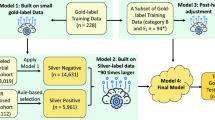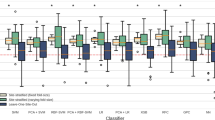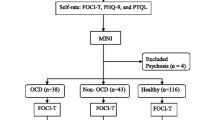Abstract
Smart healthcare becomes one of the popular research areas in recent years. This research proposes to expand the state-of-art of smart healthcare by incorporating solutions for obsessive compulsive disorder (OCD). Classification of OCD by analyzing oxidative stress biomarkers (OSBs) through a machine-learning mechanism is a significant development in the study of OCD. However, this procedure requires the collection of OCD class labels from hospitals, collection of corresponding OSBs from biochemical laboratories, integrated and labeled dataset creation, use of suitable machine-learning algorithm for designing OCD prediction model, and making these prediction models available for different biochemical laboratories for OCD prediction for unlabeled OSBs. Further, from time to time, with significant growth in the volume of the dataset with labeled samples, redesigning the prediction model is required for further use. The entire process demands distributed data collection, data integration, coordination between the hospital and the biochemical laboratory in real-time, dynamic machine-learning model design for OCD prediction, and making the machine-learning model available for the biochemical laboratories. Considering these requirements, Accu-Help a fully automated, smart, and accurate OCD detection conceptual model is proposed to help the biochemical laboratories for efficient detection of OCD from OSBs. OSBs are classified into three classes: Healthy Individual (HI), OCD Affected Individual (OAI), and Genetically Affected Individual (GAI). The main component of this proposed framework is the machine-learning-based OCD class prediction model design. Accu-Help uses a neural network-based approach with an OCD class prediction accuracy of \(86\pm 2\%\).








Similar content being viewed by others
Data Availability
An earlier version of this paper is made available as a preprint [35].
References
Olokodana IL, Mohanty SP, Kougianos E, Sherratt RS. EZcap: a novel wearable for real-time automated seizure detection from EEG signals. IEEE Trans Consum Electron. 2021;67(2):166–75.
Rachakonda L, Bapatla AK, Mohanty SP, Kougianos E. BACTmobile: a smart blood alcohol concentration tracking mechanism for smart vehicles in healthcare CPS framework. SN Comput Sci. 2022;3(3):1–24.
Amin SU, Hossain MS, Muhammad G, Alhussein M, Rahman MA. Cognitive smart healthcare for pathology detection and monitoring. IEEE Access. 2019;7:10745–53.
Vos T, Abajobir AA, Abate KH, Abbafati C, Abbas KM, Abd-Allah F, Abdulkader RS, Abdulle AM, Abebo TA, Abera SF, et al. Global, regional, and national incidence, prevalence, and years lived with disability for 328 diseases and injuries for 195 countries, 1990–2016: a systematic analysis for the Global Burden of Disease Study 2016. The Lancet. 2017;390(10100):1211–59.
Mas S, Gasso P, Morer A, Calvo A, Bargallo N, Lafuente A, Lazaro L. Integrating genetic, neuropsychological and neuroimaging data to model early-onset obsessive compulsive disorder severity. PLoS One. 2016;11(4):153846.
Aydin S, Arica N, Ergul E, Tan O. Classification of obsessive compulsive disorder by EEG complexity and hemispheric dependency measurements. Int J Neural Syst. 2015;25(03):1550010.
Erguzel TT, Ozekes S, Sayar GH, Tan O, Tarhan N. A hybrid artificial intelligence method to classify trichotillomania and obsessive compulsive disorder. Neurocomputing. 2015;161:220–8.
Desarkar P, Sinha VK, Jagadheesan K, Nizamie SH. A high resolution quantitative EEG power analysis of obsessive-compulsive disorder. Ger J Psychiatry. 2007;10(2):29–35.
Kopřivová J, Congedo M, Horáček J, Praško J, Raszka M, Brunovskỳ M, Kohútová B, Höschl C. EEG source analysis in obsessive-compulsive disorder. Clin Neurophysiol. 2011;122(9):1735–43.
Salomoni G, Grassi M, Mosini P, Riva P, Cavedini P, Bellodi L. Artificial neural network model for the prediction of obsessive-compulsive disorder treatment response. J Clin Psychopharmacol. 2009;29(4):343–9.
Hoexter MQ, Miguel EC, Diniz JB, Shavitt RG, Busatto GF, Sato JR. Predicting obsessive-compulsive disorder severity combining neuroimaging and machine learning methods. J Affect Disord. 2013;150(3):1213–6.
Weygandt M, Blecker CR, Schäfer A, Hackmack K, Haynes J-D, Vaitl D, Stark R, Schienle A. fMRI pattern recognition in obsessive-compulsive disorder. Neuroimage. 2012;60(2):1186–93.
Gehris TL, Kathol RG, Black DW, Noyes R Jr. Urinary free cortisol levels in obsessive-compulsive disorder. Psychiatry Res. 1990;32(2):151–8.
Kuloglu M, Atmaca M, Tezcan E, Gecici Ö, Tunckol H, Ustundag B. Antioxidant enzyme activities and malondialdehyde levels in patients with obsessive-compulsive disorder. Neuropsychobiology. 2002;46(1):27–32.
Ersan S, Bakir S, Ersan EE, Dogan O. Examination of free radical metabolism and antioxidant defence system elements in patients with obsessive-compulsive disorder. Prog Neuropsychopharmacol Biol Psychiatry. 2006;30(6):1039–42.
Behl A, Swami G, Sircar S, Bhatia M, Banerjee B. Relationship of possible stress-related biochemical markers to oxidative/antioxidative status in obsessive-compulsive disorder. Neuropsychobiology. 2010;61(4):210–4.
Shrivastava A, Kar SK, Sharma E, Mahdi AA, Dalal PK. A study of oxidative stress biomarkers in obsessive compulsive disorder. J Obsess-Compuls Relat Disord. 2017;15:52–6.
Nouman M, Khoo SY, Mahmud MP, Kouzani AZ. Recent advances in contactless sensing technologies for mental health monitoring. IEEE Internet Things J. 2022;9:274–97.
Jain P, Joshi AM, Mohanty SP. iGLU: an intelligent device for accurate noninvasive blood glucose-level monitoring in smart healthcare. IEEE Consum Electron Mag. 2019;9(1):35–42.
Catarinucci L, De Donno D, Mainetti L, Palano L, Patrono L, Stefanizzi ML, Tarricone L. An IoT-aware architecture for smart healthcare systems. IEEE Internet Things J. 2015;2(6):515–26.
Tripathy AK, Mohapatra AG, Mohanty SP, Kougianos E, Joshi AM, Das G. EasyBand: a wearable for safety-aware mobility during pandemic outbreak. IEEE Consum Electron Mag. 2020;9(5):57–61.
Askland KD, Garnaat S, Sibrava NJ, Boisseau CL, Strong D, Mancebo M, Greenberg B, Rasmussen S, Eisen J. Prediction of remission in obsessive compulsive disorder using a novel machine learning strategy. Int J Methods Psychiatr Res. 2015;24(2):156–69.
Lenhard F, Sauer S, Andersson E, Månsson KN, Mataix-Cols D, Rück C, Serlachius E. Prediction of outcome in internet-delivered cognitive behaviour therapy for paediatric obsessive-compulsive disorder: A machine learning approach. Int J Methods Psychiatr Res. 2018;27(1):e1576.
Piaggi P, Menicucci D, Gentili C, Handjaras G, Gemignani A, Landi A. Singular spectrum analysis and adaptive filtering enhance the functional connectivity analysis of resting state fMRI data. Int J Neural Syst. 2014;24(03):1450010.
Rangaprakash D, Hu X, Deshpande G. Phase synchronization in brain networks derived from correlation between probabilities of recurrences in functional MRI data. Int J Neural Syst. 2013;23(02):1350003.
Cheng J, Li P, Tang Y, Zhang C, Lin L, Gao J, Wang Z. Transcranial direct current stimulation improve symptoms and modulates cortical inhibition in obsessive-compulsive disorder: A TMS-EEG study. J Affect Disord. 2022;298:558–64.
Özçoban MA, Tan O, Aydin S, Akan A. Decreased global field synchronization of multichannel frontal eeg measurements in obsessive-compulsive disorders. Med Biol Eng Comput. 2018;56(2):331–8.
Kluge M, Schüssler P, Künzel HE, Dresler M, Yassouridis A, Steiger A. Increased nocturnal secretion of ACTH and cortisol in obsessive compulsive disorder. J Psychiatr Res. 2007;41(11):928–33.
Shohag MH, Ullah MA, Azad MA, Islam MS, Qusar S, Shahid SF, Hasnat A. Serum antioxidant vitamins and malondialdehyde levels in patients with obsessive-compulsive disorder. Ger J Psychiatry. 2012;15:10–14.
Kar SK, Choudhury I, et al. An empirical review on oxidative stress markers and their relevance in obsessive-compulsive disorder. Int J Nutr Pharmacol Neurol Dis. 2016;6(4):139.
Field A. Logistic regression. Discov Stat Using SPSS. 2009;264:315.
Izenman AJ. Linear discriminant analysis. In: Modern multivariate statistical techniques. Springer; 2013, p. 237–280.
Kramer O. K-nearest neighbors. In: Dimensionality reduction with unsupervised nearest neighbors. Springer; 2013. p. 13–23.
Bebis G, Georgiopoulos M. Feed-forward neural networks. IEEE Potentials. 1994;13(4):27–31.
Patel K, Tripathy AK, Padhy LN, Kar SK, Padhy SK, Mohanty SP. Accu-help: a machine learning based smart healthcare framework for accurate detection of obsessive compulsive disorder. 2022. arXiv preprint. https://arxiv.org/abs/2212.02346.
Funding
This study was funded by Odisha Higher Education Programme for Excellence and Equity (OHEPEE) World Bank (6770/GMU).
Author information
Authors and Affiliations
Corresponding author
Ethics declarations
Conflict of Interest
The author Ajaya K. Tripathy has received research grants from Odisha Higher Education Programme for Excellence and Equity (OHEPEE) World Bank.
Ethical Approval
All the procedures performed in studies involving human participants were in accordance with the ethical standards of the institutional and/or national research committee and with the 1964 Helsinki Declaration and its later amendments or comparable ethical standards.
Informed Consent
Informed consent was obtained from all individual participants included in the study.
Additional information
Publisher's Note
Springer Nature remains neutral with regard to jurisdictional claims in published maps and institutional affiliations.
Rights and permissions
Springer Nature or its licensor (e.g. a society or other partner) holds exclusive rights to this article under a publishing agreement with the author(s) or other rightsholder(s); author self-archiving of the accepted manuscript version of this article is solely governed by the terms of such publishing agreement and applicable law.
About this article
Cite this article
Patel, K., Tripathy, A.K., Padhy, L.N. et al. Accu-Help: A Machine-Learning-Based Smart Healthcare Framework for Accurate Detection of Obsessive Compulsive Disorder. SN COMPUT. SCI. 5, 36 (2024). https://doi.org/10.1007/s42979-023-02380-1
Received:
Accepted:
Published:
DOI: https://doi.org/10.1007/s42979-023-02380-1




